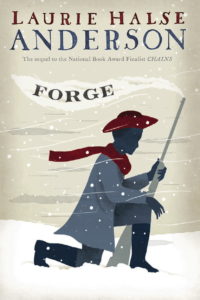I know many of you have been wondering about the contents of FORGE. Sadly, you’ll have to wait 101 days until the 10/19 publication date to really sink your teeth into it.
But Richie Partington of Richie’s Pick’s has posted the first review of it, for those who want an early taste.
“07 July 2010 FORGE by Laurie Halse Anderson, Atheneum, October 2010, 304p., ISBN: 978-1-4169-6144-5
“How many years can some people exist
before they’re allowed to be free?”
— Bob Dylan
“‘Stop there! the boy yelled.
“The redcoat glanced behind him, caught his foot on a half-buried root, and fell hard. His musket flew from his hand, but he quickly crawled to it. “‘You are my prisoner, sir,’ the boy declared in a shaky voice. ‘Lay down your musket.
‘”The redcoat had no intention of becoming a prisoner. He pulled out a gunpowder cartridge, ripped it open with his teeth, and poured powder into his firing pan. His hands were shaking so violently that most of the powder fell to the ground.”
The question that had come to me shortly after my beginning to read FORGE, and which continued to bug me was: How exactly does Laurie Halse Anderson write historical fiction so that it can be so easily read; so well enjoyed; and in such a manner that readers can connect so readily with characters who lived so long ago?
“Stop!’ The boy brought his musket up to fire. ‘I swear I’ll shoot.’ He wiped his right hand on his breeches, then cocked the firelock and slipped his finger in the trigger guard.
“The redcoat fumbled in his shot bag for a lead musketball.
“The boy squeezed the trigger. His flint hit the empty firing pan with a dull click. The musket didn’t fire. He’d forgotten to prime his pan.
“The redcoat pulled out his ramrod.
“The boy grabbed the cork out of his powder horn.
“My palms were sweating, my eyes going back and forth trying to figger who would win the race to load and shoot.”
How does she do it? It seems to come down to the employment of straightforward sentences of moderate length; details that provide a sense of the characters being young people just like the young people we know — for better or for worse — in our own lives; and a lot of great scenes, both tense ones and humorous ones. Solid writing skills that synergize into page after page of exceptional and accessible story about the historic past.
That Laurie Halse Anderson’s award-winning historical fiction can be so easily read also permits readers to more readily comprehend how what happened a long time ago can still have such significance today.
Maybe these conclusions to which I’ve arrived are obvious things you already know, but that question had really been bugging me. I have always been attracted to historical fiction, but the Revolutionary-era tales I read during my own young years always led me to feel that the characters encountered had a lot more in common with Early Man than they did with me.
In contrast, here in FORGE, every time Curzon violently (and endearingly) twists his own ear to remind himself to stop once again thinking about Isabel (our heroine from CHAINS who has saved his life at the end of the first book and with whom he loses contact), we realize that, deep down, this is just like us doing the boy-girl thing back in high school.
“I twisted my ear so often in the weeks that followed, it swelled like a puffball. Did me no good; I still thought about Isabel. Her face has poisoned my mind the way the cold had taken hold of my bones.”
FORGE is set amidst the 1777-8 winter encampment that Washington and his troops established at Valley Forge, northwest of Philadelphia. As she did so effectively in CHAINS, Anderson again begins each chapter with intriguing quotations she has compiled while doing research for these books. The writers of these quotes include unknown foot soldiers as well as a who’s who of interesting and important Revolutionary characters like Paine, Gates, Washington, Rush, Laurens, Morris, (Mrs.) Adams, and Lafayette.
“‘It would be useless for us to denounce the servitude to which the Parliament of Great Britain wishes to reduce us, while we continue to keep our fellow creatures in slavery just because their color is different from ours.’
Signer of the Declaration of Independence Dr. Benjamin Rush, who purchased William Grubber in 1776 and did not free him until 1794.“
Of course, the underlying question FORGE prompts, as did CHAINS, is: Who was actually gaining freedom through this Declaration of Independence and subsequent war, and why was it not everyone?
“How many times can a man turn his head
pretending he just doesn’t see”
The failure of the Founders to provide the appropriate answers to these questions; their permitting the continued enslavement of humans somehow justified through a difference in skin color is, of course the number one cause of America’s failure to ever live up to its true potential. The treachery that befalls Curzon here in FORGE is part of an ever-present thread that can be followed from the Revolutionary era right into our own lifetimes. Those who held power amongst the revolutionaries, along with leaders and constituents who have come in the intervening generations since, all bear responsibility for the horrors with which I’ve spent my life living: the brutal memories I both witnessed in person as a little child, and viewed again and again on the nightly news. These are the despicable and nightmarish things that have been said and done throughout our nation’s history to people of color and those of good conscience in retaliation for their standing up for what was and is fair and just.
“My head laid itself on the table and I was no longer master of my own body, of my head, of my heart and somewhere my father was angry and I did not know how to explain. My eyes closed themselves.
“I will kill Bellingham.“
All that I will say about the last section of the book (in the spring when the privies filled by ten thousand soldiers start to melt, causing the birds to start flying around the encampment instead of over it) is that the story really cranks into overdrive and that I finished up FORGE with a huge smile on my face.
Are any of you still wondering whether there is some let-down in this middle book of the trilogy?
Ha! With Laurie Halse Anderson in command? Not on your life!”
What I love about Richie’s reviews is the way he weaves together quotes from the text, plot summary, and his own reaction. You can subscribe to his reviews by joinging the Richie’s Picks group at http://groups.yahoo.com/group/richiespicks/
Be sure to take a look at his review about Susan Campbell Bartoletti’s new book, THEY CALLED THEMSELVES THE KKK: THE BIRTH OF AN AMERICAN TERRORIST GROUP. You also might be interested in the Picture Books For Older Readers list put together by some of Richie’s Library Science students.
 (What does any of this have to do with a picture of a pretty fern? Nothing. I shot the pic at camp recently and love it. Maybe ferns will be the Next Hot Thing, after libraries.)
(What does any of this have to do with a picture of a pretty fern? Nothing. I shot the pic at camp recently and love it. Maybe ferns will be the Next Hot Thing, after libraries.)



















